
Pretty much like yesterday’s Route 90, but perhaps with a few more trees. Those are mostly mesquite along the highway. Click on any image to enlarge.
22 April 2011. The good news is that the wind was much calmer today—and more out of the south than east, so the pedaling was easier. The bad news is that my legs still felt leaden by the end of what should have been a pretty easy ride: just 42 miles or so.
Now, I’m trying to figure out a route north from Uvalde (or one of the other towns between here and San Antonio) to get off the heavily traveled Route 90 and into some more beautiful country. This is a recommendation from a few people. But I’m spoiled with reasonably fast internet connections, which I don’t have here—despite what was promised. So I’m having trouble researching lodging options. Add to that frustration, one of the lights doesn’t work in my motel room, so I’m trying to squint at these highway maps. Aack!
After getting dropped off by Rhonda in Brackettville a little after 8:00 this morning, I stopped to have a sandwich made to take along for lunch (Italian sub—with Italian dressing in a small separate container). Outside the store, as I was carefully loading my precious cargo into one of my panniers, I got into a conversation with an older gentleman, Joe Factor. Joe is one of the last Seminole Indians in the town. His great-grandfather was a Seminole Scout for the U.S. Army fort here.
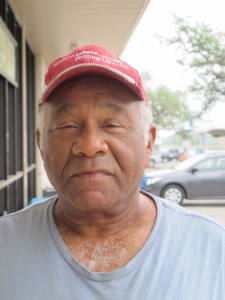
Joe Factor, now retired, is a Seminole Indian whose great grandfather was a scout for the U.S. Army, based in Brackettville.
As with many of the conversations I’ve had on this trip, it was mostly about water. Joe said the half-inch of rain they had the night before was the first since last August or September. They really need two days of a slow, soaking rain, he said. As it is, his spring is running dry.
But he painted a very positive picture of Brackettville. It’s a poor town, he said—mostly ranchers, and a lot of them giving up (in fact, I saw dozens of for-sale signs at ranch entrance gates during my biking today)—but there is virtually no crime, and whenever there’s hardship of some sort, such as someone dealing with cancer, the community pulls together and raises money. As we were chatting, several others were setting up a bake sale and raffle outside the store—though I didn’t notice the cause.
There’s a lot to look at while one pedals along, even as you watch for tire-puncturing debris on the shoulder and keep an eye out for trucks zooming up behind you. I found myself focusing on the ornate ranch gates the last few days, and I finally stopped to take a few photos.

I’ve noticed many ornate ranch gates along Route 90; often with nice plantings. This was one of the many ranches I passed that’s for sale.

The gates are all a little different, and many emphasize game hunting—which is as big a part of the economy here as true ranching today. There are lots of exotics around here raised for hunting.
Probably the high point of pedaling to Uvalde from Brackettville was seeing dozens of painted buntings along the shoulder of Route 90 and in the mesquite trees further from the highway. These are such spectacular birds! I had been disappointed to learn this morning that I had missed seeing painted buntings at the B&B where I was staying; my hosts had seen four last night after bringing my dinner over. I’m not disappointed now. I stopped to examine the first few I saw, but then they became almost commonplace.

I don’t do very well photographing little birds, so I’ve tried to capture some color with the plants. I’ll have to identify these ones later.
As I was eating my lunch, sitting on the ground, an eastbound bicyclist passed my. We waved, but he didn’t stop. Later, another bicyclist caught up with me as I was nearing Uvalde. We chatted for a couple miles, though it was a bit difficult, as there was road construction, and we had to keep weaving in and out of the traffic markers. This bloke was from Ireland, and I could barely understand a word he said. He mumbled, and seemed to enjoy not quite being understood. When he asked where I was from, I responded “Vermont.”
“Where’s that?”
“New England.”
“Where’s that?”
Now, come on. How can you be from the U.K. and visiting America and not have heard of New England? I was just as glad to see him race on ahead. He thought he was going to make it to Hondo—another 44 miles from Uvalde. I’m not sure where he had started this morning; I couldn’t understand his answer. I probably have twenty years on him, but his stamina did make me feel a little inadequate.

I’m not sure what this structure is—a radar installation, perhaps? The only signs I saw around it were federal government signs warning that poison traps had been planted, so keep your dogs away.
As I was coming into Uvalde around 2:00 or 2:30 pm and seeing what an ugly town it is (these towns always put on their worst face when you’re driving—or biking—through on the main drag), I debated pushing on another 20 miles to Sabinal. I even called to check on lodging availability (less expensive than in Uvalde) and one woman at a motel was pretty sure that there would be a restaurant that’s open tonight—though she didn’t exude confidence!
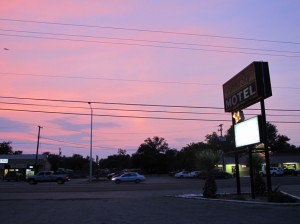
The Amber Sky Motel. I’m sitting outside now, both for better Internet connection and because I can’t stand listening to the water run in the toilet. It’s the second motel in a row (in parched country!) where the toilet has been leaking! The sunset this evening was nice.
Ultimately, my legs made the decision. Even after a break at the first convenience store coming into Uvalde, where I bought a quart of orange juice and walked over to a park across the street to guzzle it, I was ready to be done with today’s biking. Now, if I could only figure out tomorrow’s plan!

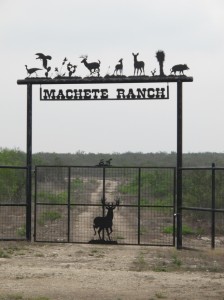

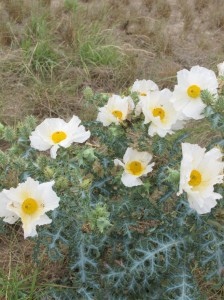
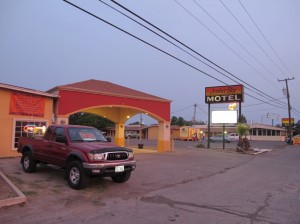
As you get closer to Austin, the ranches will become “All gate and no cattle…” (my play on the phrase “All hat and no cattle…”)
Tasteful/enlightened/thoughtful/unique/understated gates/entrances seem to be a rarity in these parts. Practical/tacky/welder/ranch-hand-designed amalgamations seem to be the rule. Perhaps as it should, or is destined to, be.
I was in Brooklyn and a man from Haiti saw my Vermont plate and asked “Do they speak English there?”
And I answered “Sort of!”
At a rest area in Wisconsin a fellow asked where I was from. When I said “Vermont”, he asked “What state’s that in?
Seminoles are Indians, either living in Florida or Oklahoma. Joe’s people were a distinct group called the Black Seminoles who were *historically associated and allied with the Seminoles in the early 1800s, but maintained their own communities and customs. They were maroons living in a very loose system of tribute slavery. In other words, they generally lived free in their own villages and fought in the wars against the Anglos, but they still had to pay tribute to Seminole chiefs each year. Intermarriage between maroons and the matrilineal Seminole Indians was the exception, not the rule. The Black Seminoles that settled in Brackettville are not members of the Seminole tribes, and ironically, they actually became Indians fighters in the western Indian Wars (they were the elite scouts of the Buffalo Soldiers). Joe is not a Seminole Indian and he is certainly not the “last” Black Seminole since there are hundreds of descendants living in Brackettville and there are also scattered communities in Mexico and even the Bahamas (Andros Island). The only Black Seminoles that are members of the Seminole tribe are in Oklahoma.
sorry tom Joe is a Seminole ,from the tribe in mexico … You cant always get the answers from just one source… The factor clan runs strong in mexico and Oklahoma .. alot of them chose not to return to Oklahoma due to tibal isues …
sorry tom Joe is a Seminole ,from the tribe in mexico … You cant always get the answers from just one source… The factor clan runs strong in mexico and Oklahoma .. A lot of them chose not to return to Oklahoma due to tribal issues …